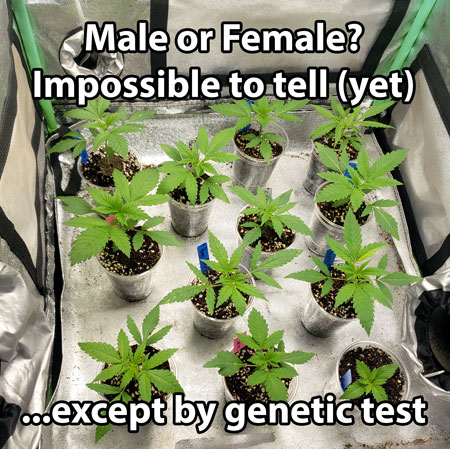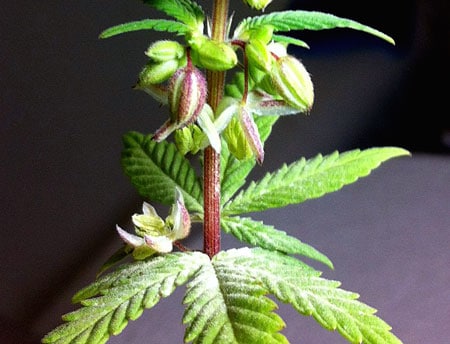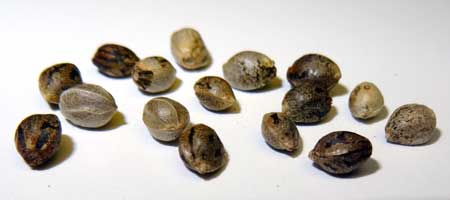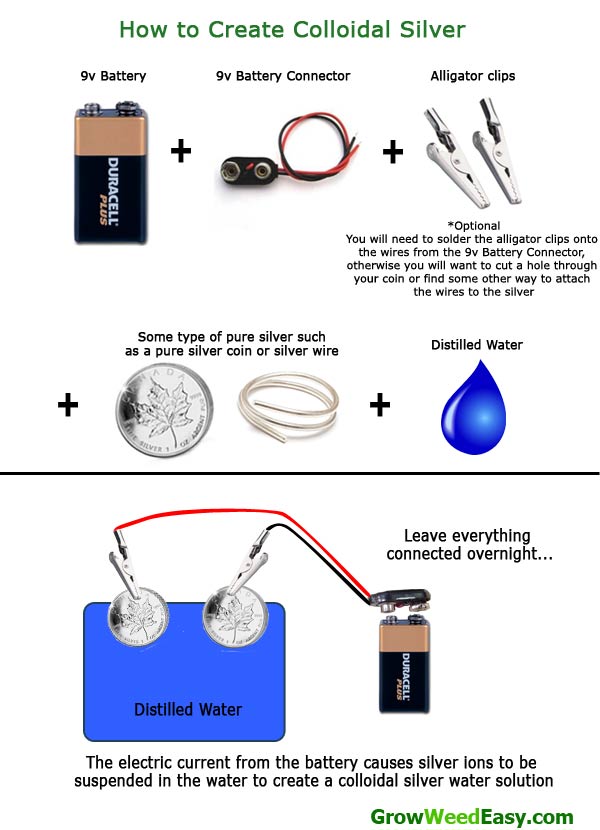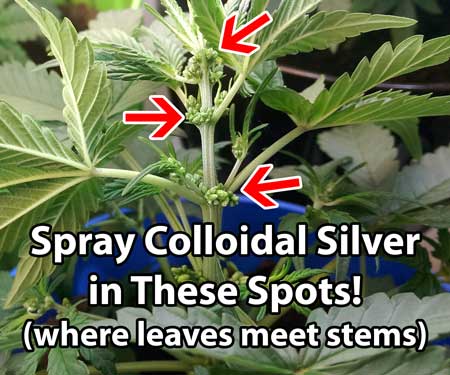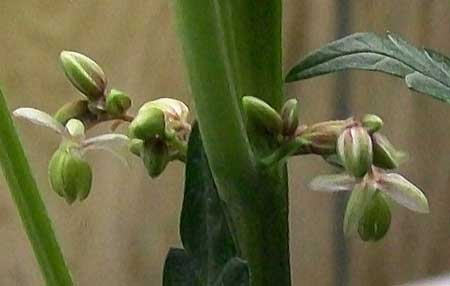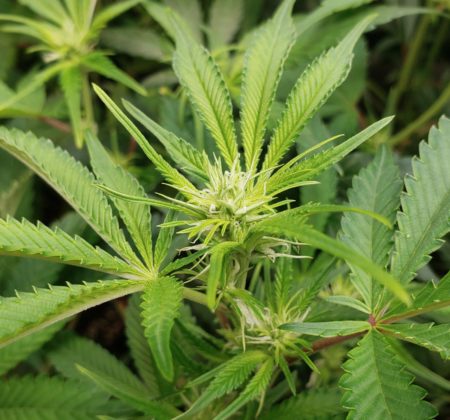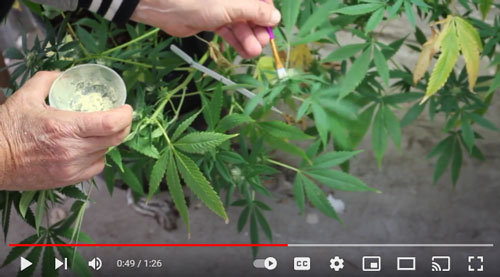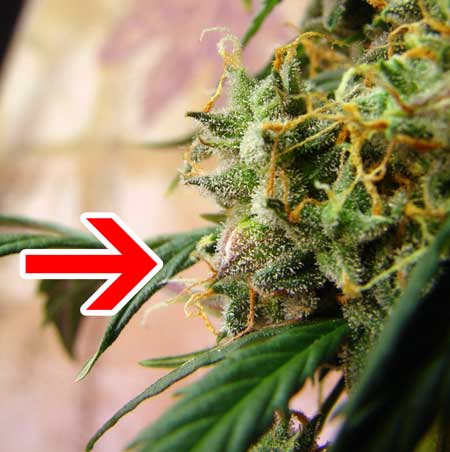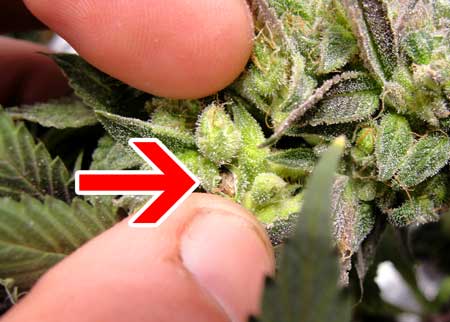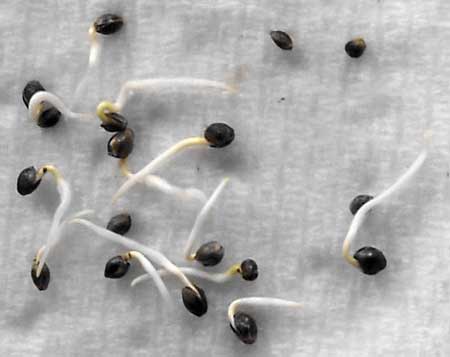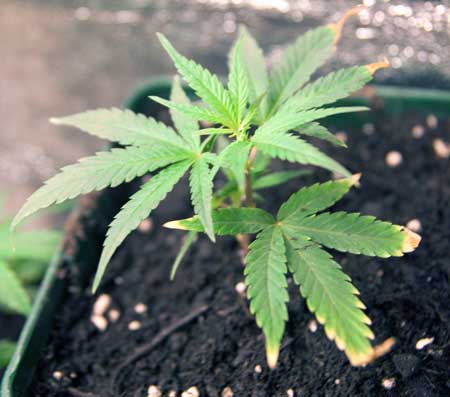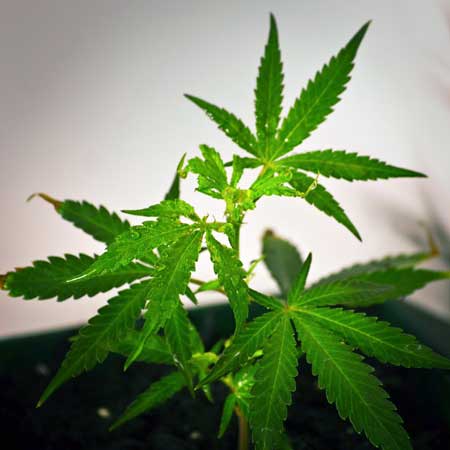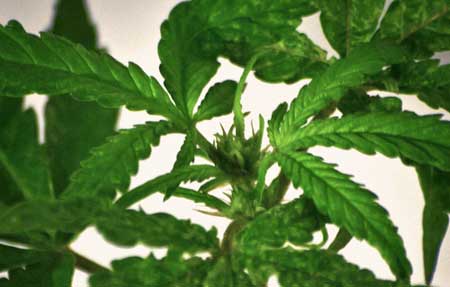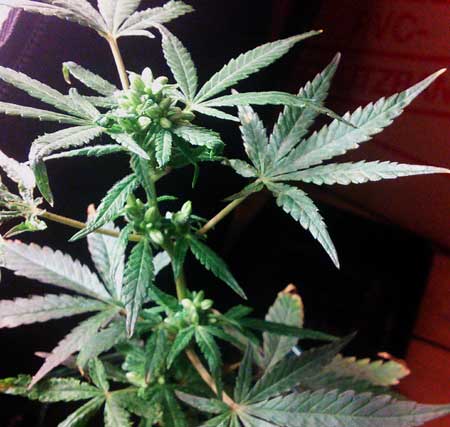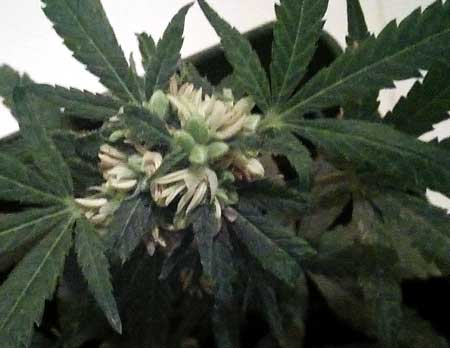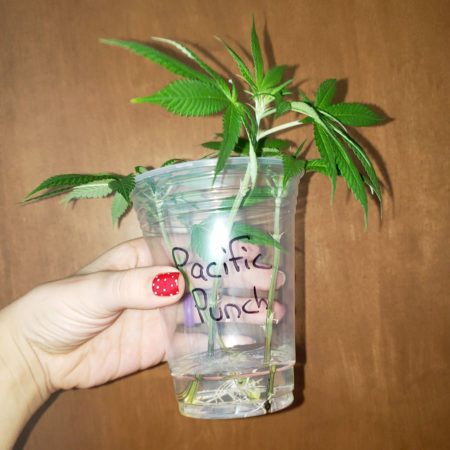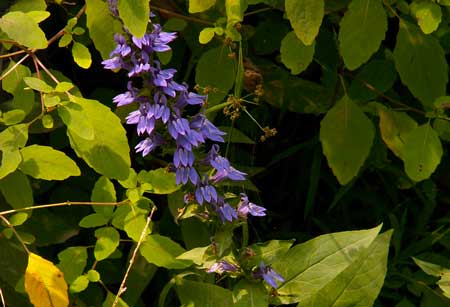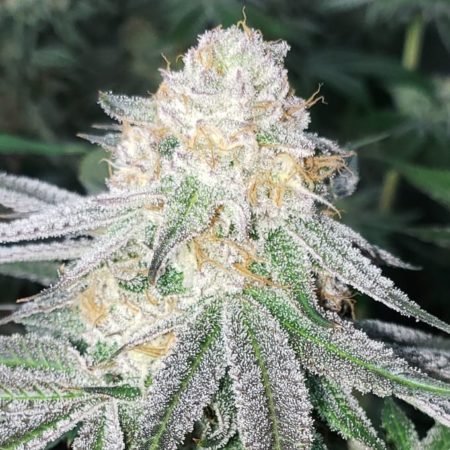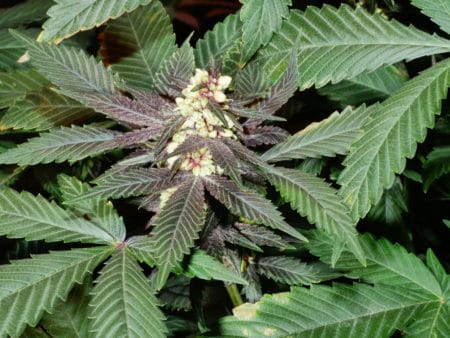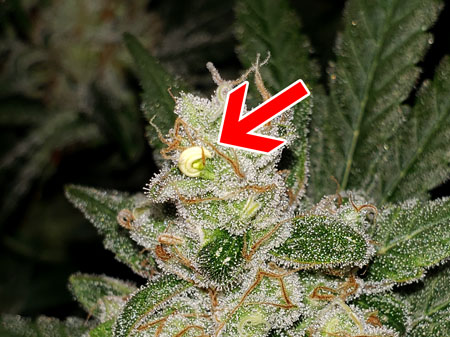by Nebula Haze (originally inspired in part by this thread from PhenoMenal)
Table of Contents
Introduction: How to Feminize Cannabis Seeds at Home
5 Steps to Feminized Seeds – Learn how to force female plants to make pollen and create feminized cannabis seeds
- How to identify sex in the vegetative stage? Learn 5 different ways to determine whether a plant is male or female before flowering begins
- Can I breed new strains using only feminized seeds?
- Will feminized seeds produce hermaphrodites (hermies)?
- Can I pollinate the same plant I used to make feminized pollen?
Introduction to Feminizing Your Own Cannabis Seeds
First of all, what are “feminized” marijuana seeds? Although male and female plants look the same when young, only female cannabis plants make buds. Male cannabis plants grow non-potent pollen sacs instead. Male plants also lower yields and cause seedy buds if they’re left among your female plants for too long. Because male plants don’t make buds and their presence reduces the quality of buds, most growers toss male plants the moment they see pollen sacs forming. However, since about half of regular cannabis seeds end up being male, that means you end up tossing half your plants once they start flowering.
Feminized seeds come from two female plants being bred together, causing all offspring to be female (which means every plant makes buds)
While regular seeds make female plants about half the time, feminized seeds only create female plants. That means you won’t need to toss half the plants once they start flowering. But how are feminized seeds made and can you make them at home?
Feminized seeds are created by breeding two female plants together. Because there are no male parents, all the resulting seeds end up being bud-bearing female plants. With feminized seeds, you can count on every plant to produce buds. Learn more about male vs female plants and feminized cannabis seeds.
Feminized seeds are available from seed banks for nearly every popular or famous strain. Breeders understand that a lot of people just want to grow plants for buds, and don’t care about making a robust breeding program (which is one of the main reasons growers want male plants).
You can’t see the difference between male and female plants until they start flowering (unless you do a genetic test). Feminized seeds ensure all plants are female so you don’t need to worry about it. You know that every plant is female from germination.
So how do seed banks feminize their seeds? How do you breed two female plants together?
The main idea is to force a female plant to produce pollen sacs like a male plant. These flowers (growing on a female plant) create pollen, which can be harvested and used to pollinate another female cannabis plant. The resulting seeds will all end up being female. Can feminizing seeds cause hermaphrodite plants?
Growers can force a female plant to make pollen sacs, and the “feminized” pollen produced can be used to fertilize another female plant. The resulting seeds will only produce female plants.
How do you force a female plant to make pollen?
There are two main ways to make feminized pollen:
- Induce feminized pollen chemically (Recommended) – This is the professional way to feminize seeds and is how reputable seed banks and breeders create feminized seeds to sell to the public. Substances that interact with plant processes such as colloidal silver or gibberellic acid are applied to bud sites of a female plant when they start flowering. Bud sites are drenched daily for the first 3-4 weeks after the switch to 12/12. This causes a female plant to produce pollen sacs which release feminized pollen when they open up. This pollen is used on another female plant to produce feminized seeds. This article will give you step-by-step instructions on how to feminize cannabis seeds using this method.
- Rhodelization (Not Recommended!) – In some cases, a female cannabis plant may naturally start making male pollen sacs or bananas, which can self-pollinate the plant. This happens if the plant is stressed, or if the plant is not harvested in time and buds start to die of old age. The plant is basically doing everything it can to make seeds and save the next generation. This method is “natural” and these seeds end up being mostly female. The problem with this method is you’re selecting for plants that naturally turn into hermies (grow both male and female sex organs) without any chemical induction. This means the resulting seeds are much more likely to turn hermie in natural conditions, too. That’s a problem if you don’t want seedy buds every time you harvest. For that reason, it’s highly recommended you don’t feminize seeds this way. It’s also a good idea to toss any and all seeds that are the result of natural herming (for example seeds you find in your buds even though you didn’t grow any male plants).
Read this article for more in-depth discussion about the pros and cons of each method, and how to avoid hermaphrodite plants when producing your own feminized seeds.
Overview: How to Make Feminized Seeds
This is a quick overview of the process, and then I’ll give the full details and steps below.
1.) Buy or Make Colloidal Silver – The article below will teach you how to make colloidal silver at home, as well as show you where to buy it if you don’t want to make it (it’s actually pretty cheap). It’s basically a solution of silver suspended in water and is available online and in health stores as a dietary supplement.
What about gibberellic acid? From what I understand it can be used exactly the same way as colloidal silver to induce female plants to produce pollen, but I don’t know the recipe for an effective gibberellic acid solution. On the other hand, I know that this exact colloidal silver method works for making feminized seeds. That’s why I’ve only included instructions for colloidal silver. If you’ve used gibberellic acid to make feminized seeds; we’d love to hear from you.
2.) Spray the bud sites of your known female plant daily during the first 3-4 weeks of the flowering stage (until pollen sacs form and start splitting open) – After switching to a 12/12 light schedule to initiate the flowering stage, choose bud sites on your known female plant, and spray/drench them daily with colloidal silver (or gibberellic acid). As the treated flowers develop, they will form into male pollen sacs instead of regular buds. Untreated bud sites on the plant will form into female buds as usual; however, these buds are unsafe to smoke unless you’ve been very careful to make sure they didn’t come into contact with colloidal silver or gibberellic acid during the feminization process as these are unsafe for smoking.
3.) Harvest “Feminized” Pollen – When pollen sacs are ready to be harvested they swell like a balloon and start to open up. Don’t harvest early! Keep spraying the bud sites daily until pollen sacs open or you might end up with empty pollen sacs. When the pollen sacs are ready, the leaf section protecting the pollen will start to crack. At this point, it’s time to collect the feminized pollen. One of the easiest ways to do this is to collect the pollen sacs directly and let them dry for a week. At that point, they can be placed in a bag and shaken to collect all the pollen.
4.) Pollinate Another Female Plant – At this point, take the feminized pollen you’ve collected and use it to pollinate a female plant that has been flowering for about 2-3 weeks (full detailed instructions with a video on how to do this below). Although it’s possible to pollinate the same plant as the original, it’s not recommended in part because the timing doesn’t match up (pollinating buds late in the flowering stage doesn’t produce many seeds). It’s best to pollinate a different female plant that you started budding a few weeks after the original. This increases the number of seeds produced as well as gives the new female plant enough time to develop them to maturity. It also increases genetic diversity compared to self-pollination.
5.) Wait ~6 Weeks After Pollination to Harvest Seeds – After about 6 weeks from pollination, the calyxes on the buds of your female plant will be swollen and fat. You know it’s time to harvest your seeds when they start bursting out. At this point, it’s time to congratulate yourself because you’ve got feminized seeds!
Now that you’ve gotten the overview, here’s the feminization process with detailed step-by-step instructions…
Step-By-Step Instructions (with pics!)
1.) Buy or Make Colloidal Silver (or Gibberellic Acid)
Where to get Colloidal Silver (your options):
Buy Ready-To-Use Colloidal Silver: Colloidal silver is sometimes used as a dietary supplement, so it’s relatively easy to find (never take it without talking to a doctor first though!). If you’re purchasing colloidal silver, try to find a solution that has at least 30 PPM (parts per million) of silver or higher.
- Buy A Colloidal Silver Generator Kit: If you plan on feminizing a lot of seeds, you may want to invest in a generator kit so you can easily make your own endless supply of colloidal silver. This is cheaper in the long run compared to buying it ready-to-use.
- Make Your Own: You can make your own colloidal silver generator at home. The following diagram illustrates what you need to do.
Note: You can purchase gibberellic acid online (a gibberellic acid solution can be used the same way as colloidal silver for feminizing seeds). However, I do not have experience with the gibberellic acid method and don’t know the best way to prepare the solution.
2.) Spray the bud sites of your known female plant daily during the first 3-4 weeks of the flowering stage (until pollen sacs form and start splitting open)
Wait until your plant is 5-6 weeks old before initiating the flowering stage. Some young plants seem to have trouble (and take much longer) to go through the feminization process, and their pollen may not be as fertile, so start with a more mature plant.
When plants are ready, change to a 12/12 light schedule to initiate flower formation and put cannabis plants in the flowering stage. Note: If you’re feminizing an auto-flowering plant, start spraying daily when the plant is about 20 days old from seed. This is when most auto-flowering cannabis strains start making flowers.
As soon as you change the light schedule (and maybe even a day or two before) start spraying your plants thoroughly with colloidal silver at every bud site you want to form into pollen sacs.
Spray bud sites thoroughly, drenching them with colloidal silver every single day. Bud sites are located wherever leaves meet stems.
The above pic shows you where pollen sacs form on the plant (the same places female buds form).
Important! Keep spraying daily until pollen sacs open up. Don’t stop spraying early, even if pollen sacs appear to be already formed, otherwise they may not produce much pollen
A spray bottle / mister is really helpful for spraying bud sites evenly and thoroughly
You can choose to treat a single bud site or all the bud sites on the plant. Any untreated bud sites will develop into female buds as usual. If you want to smoke these buds, it’s incredibly important to avoid letting them come into contact with colloidal silver because silver is not safe to smoke. (Don’t worry, feminized seeds don’t contain any silver). I highly recommend letting the whole plant be your test subject so you don’t have to worry about that 🙂
3.) Harvest Your Feminized Pollen
When pollen sacs are starting to crack and look like they’re about to open up (or if you can see one has already opened) then your pollen is ready for harvest!
When pollen sacs are cracking and opening up, you’re ready to harvest your pollen!
Pollen spilling onto a nearby leaf
One way to harvest your pollen is to gently and carefully remove all the pollen sacs. Let them dry in open air for a week, and then put them in a resealable bag. If you shake the bag the pollen should easily spill out. You may need to cut a few open yourself.
How to Store Feminized Pollen: Moisture is your main enemy when storing pollen. It can help to double the mass of the pollen collected by adding regular cooking flour. This absorbs moisture during storage and as an added bonus, it increases the volume to make application easier when you get to pollinating. If pollen is totally dry and you triple-bag the pollen-flour mixture and stick it in the freezer (with a good nametag so you know where the pollen came from), your pollen can be stored for a year or longer. You can add a few silica packs (which suck out any remaining moisture) in the bag to make extra sure that the pollen stays totally dry.
4.) Pollinate Another Female Plant
When your chosen mother is 2-3 weeks into the flowering stage, take a small paintbrush or powder brush and ‘paint’ your feminized pollen on the developing bud sites you want to pollinate. Bud sites (for both male and female plants) are located wherever you can see leaves meet a stem.
Buds are ready to get pollinated when they look like little bunches of white hairs
Only the buds that come in contact with pollen will grow seeds. You can choose to pollinate all of your buds or just a few on the plant.
Here’s a video by Ed Rosenthal on Youtube showing you how to pollinate buds with pollen. Make sure to touch all the female pistils/hairs with your pollen.
5.) Wait About 6 Weeks Then Harvest Seeds
It usually takes about 6 weeks for your feminized seeds to fully develop. Some plants are literally dying right as the seeds become ready, so to get the most viable seeds, you need to try to keep it alive until the seeds actually start dropping. The seeds can be used right away, or stored in a cool, dry place for a few years. Don’t forget to label them with the date.
This seed is about to burst out of its calyx
This is what it looks like when the seed is exposed
Now it’s time to germinate your feminized seeds!
Picture Journal of Making Feminized Pollen with Colloidal Silver
This grower initiated the feminization process on a seedling that was only a few weeks old. As a result, the plant wasn’t able to get big enough to produce many pollen sacs. You will get even better results if you start with a plant that is at least 5 weeks old 🙂
October 18 – Plant right before the switch to 12/12
October 27 – After being drenched with colloidal silver daily for a little over a week
October 30 – Pollen sacs are forming
November 15 – Pollen sacs appear to be almost fully formed and are swelling in size, but haven’t opened up yet. Don’t stop spraying colloidal silver or you may end up with empty sacs!
November 27 – Pollen sacs are opening up! Collect the pollen before they’re all open!
FAQs – Frequently Asked Questions
How can I identify plant gender before the plant actually starts flowering?
There are a few ways to identify plant gender before the plant actually starts flowering, and each is helpful in different situations.
- Use feminized seeds – All your plants will be female if you start with pre-made feminized seeds.
- Start with a clone – A clone is an exact copy of another plant. If the “mother” of the clone is a female plant, it means the clone is also female
- Look at preflowers (identify plants when they’re 3-6 weeks from seed) – If you know where to look, cannabis plants will actually reveal their gender in the vegetative stage when they’re just 3-6 weeks from seeds. Male plants usually show their gender by 3-6 weeks and female plants usually show their gender around week 4-8 from seed. Learn how to determine the sex in the veg stage by looking at preflowers.
- Test the leaves of your seedling in a lab – It’s possible to send in a leaf from a young cannabis plant to a specialized testing company, and they will be able to determine the gender as soon as 3 weeks from seed! Although I haven’t used any of these companies and can’t recommend any in particular, here’s a link to one example just so you can see what I’m talking about. From talking to other growers who use this method, it appears to be accurate.
- Take a clone and force it to start flowering – if you take a clone from a vegetative plant, you can force that clone to start flowering and reveal its gender. You’ll know the sex of the “parent” plant by the sex expressed by the clone. This is what I do to determine the sex. I cut off a piece of the plant, stick it in a glass of water (don’t forget to label it with the strain), and give it a 12/12 light schedule until the little piece starts forming either pollen sacs or buds.
The easiest way to identify sex with unknown seedlings? Cut off a small branch of the plant, stick it in a cup of water with a label, and keep it in a sunny window on a 12/12 light schedule until buds or pollen sacs start forming. As long as the plant is getting bright light in the day and long dark nights, it will reveal its sex in just a few weeks (you don’t even need to wait for roots to form).
Can I Make a Breeding Program Using Just Female Plants and Feminized Seeds?
Yes, it’s possible to use just female plants and feminized seeds for further breeding, with one major caveat.
Without careful and thorough testing, it may be possible to accidentally select cannabis plants that tend to herm (make male flowers or pollen) and cause seedy buds when you don’t want them to.
For each possible “mother,” clones should be grown in several different environments and tested thoroughly to make sure that the mother plant does not have any tendency to make pollen naturally in normal or stressful conditions. It’s okay if plants grow pollen sacs if induced chemically since that is very unlikely to happen in someone’s garden on accident, but you don’t want plants that will start growing male flowers on their own without chemical induction. Thorough testing of plant hardiness is always important when breeding, but it may be especially important when breeding feminized seeds together.
Are there other reasons I should avoid breeding seeds without males?
The most common reason growers say you shouldn’t do this is because it’s “unnatural” or doesn’t “seem right.” Some growers say you need male plants for genetic diversity. I’ve also heard growers say that the resulting plants will be weaker, sterile, and less potent. Someone once even told me that resulting plants “will be worse in every way.”
As of yet, I haven’t seen any of these claims backed by actual personal experience, or any real-life examples showing why using feminized seeds is not a viable way to breed new strains.
To those who say this type of reproduction just doesn’t seem right, the evolutionary strategy of plants using only female and hermaphrodite plants to breed is actually pretty common and is known as gynodioecy. One example of a plant that only reproduces this way is a flower found in Canada and the US called Lobelia siphilitica, also known as the Great Lobelia. Obviously, this reproduction method isn’t exactly the same as artificial feminization since the pollen production is caused naturally instead of induced chemically, but examples of gynodioecy show that a female flower-based breeding population can exist in the wild even when no plants are purely male.
The Great Lobelia naturally reproduces using only female and hermaphrodite plants. This is similar to the cannabis feminization process because it results in a population of plants that all primarily grow female flowers, with no pure male plants
When it comes to genetic diversity, the ability to cross out to thousands of different cannabis strains allows you to dramatically increase the gene pool without using male plants. So those are my answers to the common objections of a feminized seed-based breeding program, however I am just a theory-crafter when it comes to this topic. It certainly seems possible that a feminized-only breeding program could run into unforeseen problems down the road, but as far as I know there isn’t any evidence of that so far.
Although I have a few anecdotes from growers who have used only feminized seeds for a few generations, it would be much better to share information from someone who has conducted plenty of testing over several generations. We’d love to hear from you if you have bred more than a few generations using only feminized seeds and want to share your experience.
What are the positive aspects of breeding two feminized seeds together?
Besides not having to worry about male plants in the next generation, the main advantage of doing this is you have a much better idea of what you’re working with when it comes to producing the type of buds you’re looking for. When you’re growing a male plant, it has several genes it will pass to its offspring that has to do with how buds develop, but since it’s a male plant those genes aren’t expressed and it’s hard to figure out what they are.
Historically, the way to learn more about the “hidden genes” contained in a male plant is to breed it to several well-known female plants and see how the offspring compare to each other. The genes that don’t come from the known mother plant are assumed to come from the male. Another way of going about this is to take several clones of the same well-known female plant and breed them with many different male plants to see which ones produce the best offspring.
After testing with several pairings, you start to get an idea of the hidden genes a male plant has to offer to its female offspring. This time-consuming process of documenting and identifying good male plants is why proven stud male plants are one of the most valuable and closely guarded types of clones available today.
But the process of finding the right “father” is a little different when you start with two female plants. In this case, you already know quite a bit about the genes of both parents because you can just look at and test the buds of both plants directly. This allows you to pinpoint desirable genes with less guessing and much less time spent growing out and cataloging plants.
Breeding two female plants together offer hints about what kind of buds their genes will produce
Why even have male plants then?
In nature, male plants are effective at increasing genetic diversity by ensuring cross-pollination. With only purely male and purely female plants, every resulting seed will have two different parents.
Another big advantage in the wild of having separate female and male plants is sexual specialization. In other words, plants are able to evolve male and female traits separately, so each type of flower can become more specialized at its unique “job.”
However, this isn’t the only successful breeding strategy for plants. In fact, only 6-7% of plants have completely separate male and female plants like cannabis plants do (known as dioecious plants). Most plants grow some mix of male and female flowers on each plant, with different combinations offering different evolutionary benefits.
You might enjoy this scientific article if you want to learn more about the evolution of sex determination in plants and animals: Sex Determination: Why So Many Ways of Doing It?
And although most cannabis strains (at least the good ones) display either purely male or purely female flowers, there are some wild populations (and some strains of hemp) that regularly produce plants with male and female parts on the same plant.
When it comes to artificial selection for breeding new strains, the grower is in charge of cross-pollination, so there’s no need for the plant to specialize in male parts. Pretty much the only thing most growers care about is how female flowers develop. So (unlike in nature) growers have the freedom to choose plants that improve female buds without even having to consider how it might affect male plants.
Only a small percentage of plant species produce male plants like cannabis.
Can feminizing seeds result in hermaphrodite plants?
The answer is yes. If you do it the wrong way then feminization can lead to plants with an increased chance of herming. However, with a well-tested and well-bred feminization program, one of the main goals is to breed out any plants with hermaphroditic tendencies that show up under normal conditions. When you buy feminized seeds from trustworthy breeders, you can count on the fact that every plant will end up growing only female flowers and that’s it.
This is a relatively big topic with a lot of opposing opinions so I wrote a whole article about it.
Feminizing seeds the wrong way can result in hermaphrodite plants.
Can I pollinate the same plant I collected the pollen from?
Yes, it’s possible. However, it’s not really recommended because, for one, the timing doesn’t match up. By the time your pollen is ready to use, your original plant will already be several weeks past the optimum pollination point. It’s best to pollinate a female plant that has only been flowering about 2-3 weeks, but pollen sacs need more time before pollen is ready to use. It’s also possible to run into unwanted side effects from self-pollination/in-breeding.
One thing to keep in mind is even if you pollinate a plant to itself, the resulting seeds are likely not going to be exact copies of the original (unless the original plant is extremely inbred). The resulting seeds include not just the mother’s expressed genes but also her hidden ones.
Learn more about breeding methods, backcrossing, and how to create & stabilize a new strain


